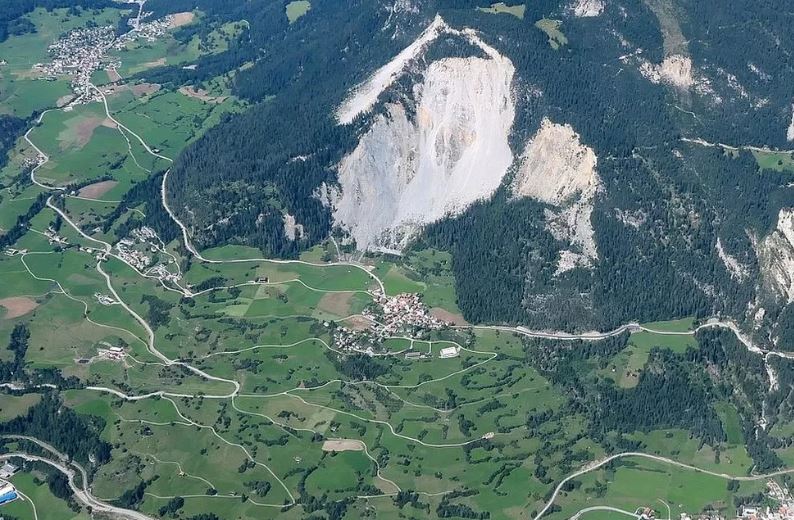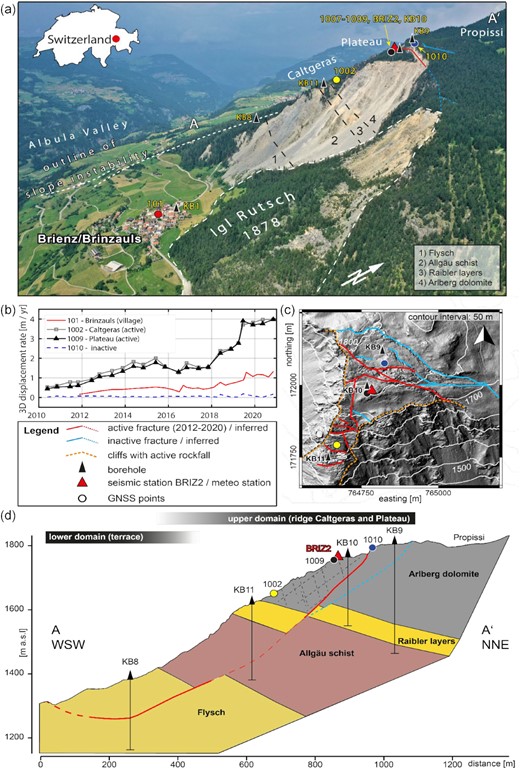10 May 2023
The very large incipient rockslide at Brienz in Switzerland
Posted by Dave Petley
The very large incipient rockslide at Brienz in Switzerland
In the Swiss canton of Graubünden, a village named Brienz (or Brinzauls) in the municipality of Albula/Alvra has been evacuated due to an incipient, large rockslide. The BBC has a good write up of the situation – the slope above the village, and indeed under the settlement itself, shown below, has been moving for many years, but has accelerated in recent months. Parts of the slope are reported to be moving at 32 metres per year, and the mobile volume is about 2 million m³.

The rockslide above Brienz in eastern Switzerland. Image by CHRISTOPH NÄNNI, TIEFBAUAMT GR, SWITZERLAND via the BBC.
.
Swissinfo has a more detailed description of the situation in the village:-
The municipality in canton Graubünden has activated the “orange phase” and therefore the evacuation of the village, which has a population of about 130.
As of Friday evening nobody will be allowed to stay overnight in the village until further notice. From Saturday villagers will be allowed into Brienz/Brinzauls during the day, if the danger level permits. Livestock from two farms will remain in the stables for the time being, the authorities said.
All access roads to Brienz/Brinzauls are now open only to residents and homeowners. On Tuesday evening the authorities will provide information on the details of the evacuation during a public information event in the nearby village of Tiefencastel.
The local authority has a detailed site dedicated to the rockslide (in German). It notes that the landslide, which includes the village itself, has been moving since the ice age, with movement rates of a few centimetres per year. It accelerated about 20 years ago, with movement rates until the current crisis of about a metre per year.
Some research on the landslide at Brienz has been published (Häusler et al. 2021), noting that the landslide is part of a much larger area of deep-seated gravitational slope deformation. The paper includes this image that summarises the setting of the landslide:-

Overview of the Brienz landslide by Häusler et al. (2021).
Original caption: Overview of the deep-seated landslide at Brinzauls, with focus on the Plateau subdomain. (a) Photograph of the Brinzauls rock instability (view towards northwest) with drilling locations, GNSS (Global Navigation Satellite System) monitoring positions and seismometer location. (b) Displacement time-series at selected locations marked on panel (a). (c) Elevation model and simplified geomorphological map of the Plateau (see Fig. S1 for details). (d) Geological profile along the ridge Caltgeras. Photograph panel (a) by courtesy of SRF Einstein. Elevation model in panel (c) provided by courtesy of AWN. Coordinate frame LV03 (WGS84: 46.679, 9.593).
.
Predicting the short term behaviour of very large, complex landslides in extremely challenging, as was shown in the Mannen rockslide in Norway. That this slope will eventually fail is close to being certain, but when and exactly how is less clear. Those involved in Switzerland are doing a fine job of managing the risk and of keeping the pubic informed.
.
Acknowledgement
Thanks to Charles Hunt for highlighting this one to me.
.
Reference
Häusler, M., Gischig, V., Thöny, R., Glueer, F. and Donat, F. 2021. Monitoring the changing seismic site response of a fast-moving rockslide (Brienz/Brinzauls, Switzerland). Geophysical Journal International, 229 [1], 299–310, https://doi.org/10.1093/gji/ggab473


 Dave Petley is the Vice-Chancellor of the University of Hull in the United Kingdom. His blog provides commentary and analysis of landslide events occurring worldwide, including the landslides themselves, latest research, and conferences and meetings.
Dave Petley is the Vice-Chancellor of the University of Hull in the United Kingdom. His blog provides commentary and analysis of landslide events occurring worldwide, including the landslides themselves, latest research, and conferences and meetings.
Fascinating article
Thanks